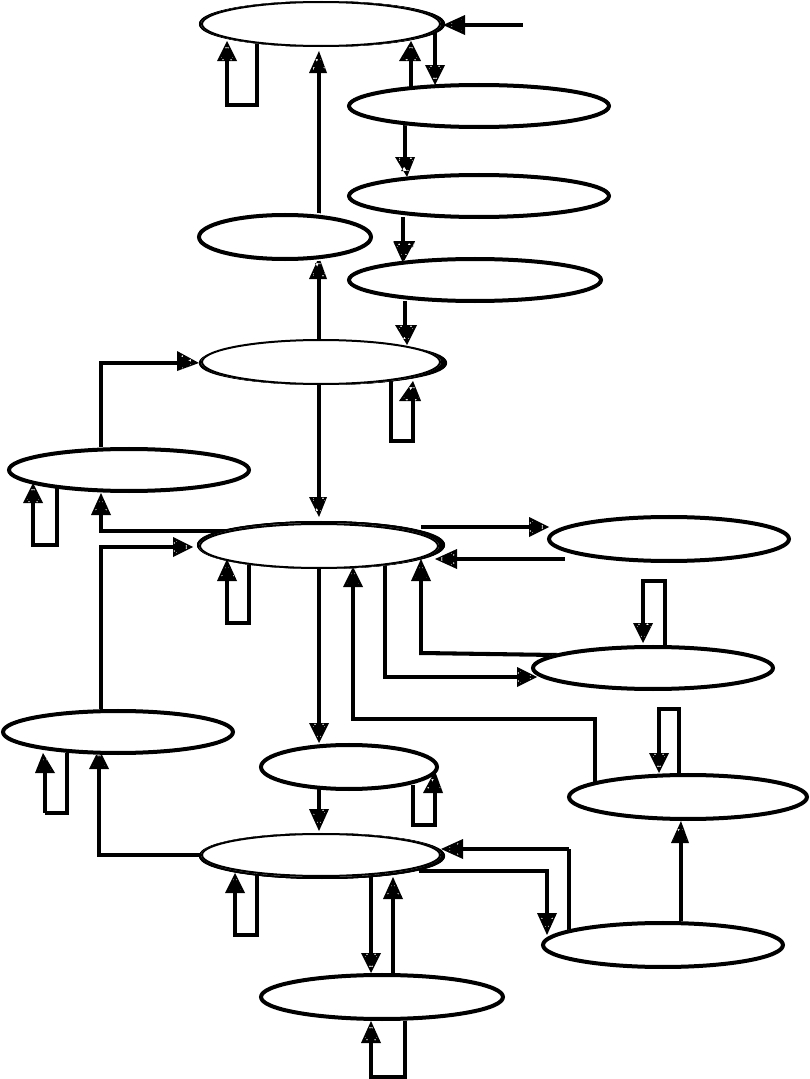Спецификация протокола Profibus
Подождите немного. Документ загружается.


Page 791
PROFIBUS-Specification-Normative-Parts-8:1997
Copyright by PNO 1997 - all rights reserved
13.3.1.2 State Machine Description
For each possible DP-Slave a state machine (Slave-Handler) is established and
started by a superior state machine, the Scheduler. The Scheduler controls the
Slave-Handler through the primitives:
- Start_Slave_Handler.req
- Continue_Slave_Handler.req (Output_Clear)
The parameter Output_Clear (Boolean) indicates that not the
output data but zero has to be sent.
- Stop_Slave_Handler.req
The Slave-Handler indicates the result of the processing by means of the
following primitives to the Scheduler:
- Start_Slave_Handler.con
- Continue_Slave_Handler.con (Diag)
The parameter Diag (Boolean) indicates whether a regular data
exchange has taken place or not.
This parameter has the value false if DDLM_Data_Exchange was performed
successfully for a DP-Slave that is marked as active in the DP-Slave parameter
set. This bit is true in all other cases.
This parameter is always true for DP-Slaves which are marked in the DP-Slave
parameter set as not active.
- Stop_Slave_Handler.con
The Slave-Handlers additionally communicate with the user via the data
interface.
The Slave-Handler manages the individual states for every DP-Slave. The
following main states will be distinguished:
- diagnostic
- parametrization
- configuration
- data exchange
The user and the Slave-Handler communicate via the data interface using the
parameter a) to g):
Legend:
-r will only be read by the Slave-Handler and written by the User
-w will only be written by the Slave-Handler and read by the User
a) Active
(Sl_Flag.7) -r
Indicates whether the DP-Slave should be activated (=True) or not. In the second
case the state machine do not reach the state DATA.
b) New_Prm
(Sl_Flag.6) -r/-w
Indicates whether new parameter data are available for the DP-Slave.
c) Prm_Data
(Octet-String) -r
Parameter data of the DP-Slave. Structure see section "Send Parameter Data" of
the interface DDLM - User-Interface.

Page 792
PROFIBUS-Specification-Normative-Parts-8:1997
Copyright by PNO 1997 - all rights reserved
d) Cfg_Data
(Octet-String) -r
Configuration data of the DP-Slave. Structure see section "Check Configuration
Data" of the interface DDLM - User-Interface.
e) Output_Data
(Octet-String) -r
Output data for the DP-Slave.
f) Input_Data
(Octet-String) -w
Input data for the DP-Slave.
g) Diag_Data
(Octet-String) -w
Diagnostic information of the DP-Slave. Structure see section "Read DP-Slave
Diagnostic Information".
The Slave-Handler changes the following flags of the diagnostic information:
Diag.Invalid_Slave_Response
Diag.Station_Non_Existent
Diag.Deactivated
System_Diagnostic[Slave_Address]
The remaining diagnostic information will be transferred directly in the
Diag_Data at the data interface after each DDLM_Slave_Diag.con.
The Slave-Handler uses the following internal variables. These variables are
preset at initialization of the device and are used by the Slave-Handler.
a) exp_Inp_len
(Unsigned8)
Specifies the number of input data octets which are expected from the DP-Slave.
b) Internal_Data_Transfer_List[x]
(Boolean)
The Slave-Handler marks in this list whether a regular Data_Exchange function
could be executed with the corresponding DP-Slave.
13.3.1.3 State Transitions
Power-On PON STOP
STOP WAIT1 DEACT
Start_Slave_Handler.req
\Sl_Para_Exist=False OR Active=False
=> Start_Slave_Handler.con

Page 793
PROFIBUS-Specification-Normative-Parts-8:1997
Copyright by PNO 1997 - all rights reserved
STOP INI1 DIAG1
Start_Slave_Handler.req
\Sl_Para_Exist=True AND Active=True
=> System_Diagnostic[x]=1
Diag.Invalid_Slave_Response = False
Diag.Deactivated = False
Start_Slave_Handler.con
DEACT WAIT2 STOP
Stop_Slave_Handler.req
=> Stop_Slave_Handler.con
DEACT WAIT3 DEACT
Continue_Slave_Handler.req(Output_Clear)
\Sl_Para_Exist=False OR Active=False
=> Continue_Slave_Handler.con(Diag=False)
DEACT INI2 WDIAG1
Continue_Slave_Handler.req(Output_Clear)
\Sl_Para_Exist=True AND Active =True
=> System_Diagnostic[x] = 1
Diag.Invalid_Slave_Response = False
Diag.Deactivated = False
DDLM_Slave_Diag.req
Continue_Slave_Handler.con(Diag=True)
DIAG1 CONT1 WDIAG1
Continue_Slave_Handler.req(Output_Clear)
=> DDLM_Slave_Diag.req
DIAG1 STOP1 STOP
Stop_Slave_Handler.req
=> Diag.Deactivated = True
Stop_Slave_Handler.con
WDIAG1 DEA0 DEACT
DDLM_Slave_Diag.con
\Active=False
=> Diag.Deactivated = True
System_Diagnostic[x] = 0
Continue_Slave_Handler.con(Diag=False)
WDIAG1 NA0 DIAG1
DDLM_Slave_Diag.con
\Active=True AND Status=NA
=> Diag.Station_Non_Existent = True
Continue_Slave_Handler.con(Diag=True)
WDIAG1 RE0 DIAG1
DDLM_Slave_Diag.con
\Active=True AND Status=RE/RS/NR/UE
=> Diag.Invalid_Slave_Response = True
Diag.Station_Non_Existent = False
Continue_Slave_Handler.con(Diag=True)
WDIAG1 DS0 DIAG1
DDLM_Slave_Diag.con
\Active =True AND Status=DS
=> Continue_Slave_Handler.con(Diag=True)

Page 794
PROFIBUS-Specification-Normative-Parts-8:1997
Copyright by PNO 1997 - all rights reserved
WDIAG1 LOCK DIAG1
DDLM_Slave_Diag.con
\Active=True AND Status=OK AND Master_Lock=True
=> Continue_Slave_Handler.con(Diag=True)
WDIAG1 OK0 PRM
DDLM_Slave_Diag.con
\Active=True AND Status=OK AND Master_Lock=False
=> New_Prm = False
Continue_Slave_Handler.con(Diag=True)
PRM CONT2 WPRM
Continue_Slave_Handler.req(Output_Clear)
=> DDLM_Set_Prm.req(Prm_Data: Lock_Req=True,
Unlock_Req=False)
PRM STOP2 STOP
Stop_Slave_Handler.req
=> Diag_Deactivated = True
Stop_Slave_Handler.con
WPRM DEA1 UNLCK
DDLM_Set_Prm.con
\Active=False
=> Continue_Slave_Handler.con(Diag=False)
WPRM DS1 PRM
DDLM_Set_Prm.con
\Active=True AND Status=DS
=> Continue_Slave_Handler.con(Diag=True)
WPRM NA1 DIAG1
DDLM_Set_Prm.con
\Active=True AND Status=NA
=> Diag.Station_Non_Existent = True
Continue_Slave_Handler.con(Diag=True)
WPRM RE1 DIAG1
DDLM_Set_Prm.con
\Active=True AND Status=RE/RS/RR/UE
=> Diag.Invalid_Slave_Response = True
Continue_Slave_Handler.con(Diag=True)
WPRM OK1 CFG
DDLM_Set_Prm.con
\Active=True AND Status=OK
=> Continue_Slave_Handler.con(Diag=True)
CFG CONT3 WCFG
Continue_Slave_Handler.req(Output_Clear)
=> DDLM_Chk_Cfg.req(Cfg_Data)
CFG STOP3 SUNLCK
Stop_Slave_Handler.req
=> DDLM_Set_Prm.req(Prm_Data: Unlock_Req=True)
WCFG DEA2 UNLCK
DDLM_Chk_Cfg.con
\Active=False
=> Continue_Slave_Handler.con(Diag=False)

Page 795
PROFIBUS-Specification-Normative-Parts-8:1997
Copyright by PNO 1997 - all rights reserved
WCFG DS2 CFG
DDLM_Chk_Cfg.con
\Active=True AND Status=DS
=> Continue_Slave_Handler.con(Diag=True)
WCFG NA2 DIAG1
DDLM_Chk_Cfg.con
\Active=True AND Status=NA
=> Diag.Station_Non_Existent = True
Continue_Slave_Handler.con(Diag=True)
WCFG RE2 DIAG1
DDLM_Chk_Cfg.con
\Active=True AND Status=RE/RS/RR/UE
=> Diag.Invalid_Slave_Response = True
Continue_Slave_Handler.con(Diag=True)
WCFG OK2 DIAG2
DDLM_Chk_Cfg.con
\Active=True AND Status=OK
=> Continue_Slave_Handler.con(Diag=True)
DIAG2 CONT4 WDIAG2
Continue_Slave_Handler.req(Output_Clear)
=> DDLM_Slave_Diag.req
DIAG2 STOP4 SUNLCK
Stop_Slave_Handler.req
=> DDLM_Set_Prm.req(Prm_Data: Unlock_Req=True)
WDIAG2 DEA3 UNLCK
DDLM_Slave_Diag.con
\Active=False
=> Input_Data=0
Continue_Slave_Handler.con(Diag=False)
WDIAG2 DS3 DIAG2
DDLM_Slave_Diag.con
\Active=True AND Status=DS
=> Continue_Slave_Handler.con(Diag=True)
WDIAG2 NA3 DIAG2
DDLM_Slave_Diag.con
\Active=True AND Status=NA
=> Diag.Station_Non_Existent = True
System_Diagnostic[x] = 1
Continue_Slave_Handler.con(Diag=True)
WDIAG2 RE3 DIAG1
DDLM_Slave_Diag.con
\Active=True AND Status=RE/RS/RR/UE
=> Input_Data=0
Diag.Station_Non_Existent = False
Diag.Invalid_Slave_Response = True
System_Diagnostic[x] = 1
Continue_Slave_Handler.con(Diag=True)

Page 796
PROFIBUS-Specification-Normative-Parts-8:1997
Copyright by PNO 1997 - all rights reserved
WDIAG2 RJ0 DIAG1
DDLM_Slave_Diag.con
\Active=True AND Status=OK AND
(Prm_Fault=True OR Cfg_Fault = True Or Prm_Req = True
OR Master_Lock=True)
=> Input_Data=0
System_Diagnostic[x] = 1
Continue_Slave_Handler.con(Diag=True)
WDIAG2 WT0 DIAG2
DDLM_Slave_Diag.con
\Active=True AND Status=OK AND Prm_Fault=False
AND Cfg_Fault=False AND Prm_Req=False AND Master_Lock=False
AND (Station_Not_Ready = True OR Stat_Diag=True)
=> System_Diagnostic[x] = 1
Continue_Slave_Handler.con(Diag=True)
WDIAG2 OK3 DATA
DDLM_Slave_Diag.con
\Active=True AND Status=OK AND Prm_Fault=False
AND Cfg_Fault=False AND Prm_Req=False
AND Station_Not_Ready=False AND Master_Lock=False
AND Stat_Diag=False AND Ext_Diag=False
=> System_Diagnostic[x]=0
Continue_Slave_Handler.con(Diag=True)
WDIAG2 EXD1 DATA
DDLM_Slave_Diag.con
\Active=True AND Status=OK AND Prm_Fault=False
AND Cfg_Fault=False AND Prm_Req=False
AND Station_Not_Ready=False AND Master_Lock=False
AND Stat_Diag=False AND Ext_Diag=True
=> System_Diagnostic[x]=1
Continue_Slave_Handler.con(Diag=True)
DATA CONT5 WDATA
Continue_Slave_Handler.req(Output_Clear)
\Output_Clear=True AND New_Prm=False
=> DDLM_Data_Exchange.req(Outp_Data=0)
DATA CONT6 WDATA
Continue_Slave_Handler.req(Output_Clear)
\Output_Clear=False AND New_Prm=False
=> DDLM_Data_Exchange.req(Outp_Data=Output_Data)
DATA CONT7 WDATA
Continue_Slave_Handler.req(Output_Clear)
\New_Prm=True
=> DDLM_Set_Prm.req(Prm_Data: Lock_Req=True,
Unlock_Req=False)
DATA STOP5 SUNLCK
Stop_Slave_Handler.req
=> DDLM_Set_Prm.req(Prm_Data: Unlock_Req=True)

Page 797
PROFIBUS-Specification-Normative-Parts-8:1997
Copyright by PNO 1997 - all rights reserved
WDATA DEA4 UNLCK
DDLM_Data_Exchange.con
\Active=False
=> Input_Data=0
Diag.Station_Non_Existent=False
Continue_Slave_Handler.con(Diag=False)
WDATA DS4 DATA
DDLM_Data_Exchange.con
\Active=True AND Status=DS
=> Continue_Slave_Handler.con(Diag=True)
WDATA NA4 DATA
DDLM_Data_Exchange.con
\Active=True AND Status=NA
=> Diag.Station_Non_Existent=True
System_Diagnostic[x]=1
Continue_Slave_Handler.con(Diag=True)
WDATA RE4 DIAG1
DDLM_Data_Exchange.con
\Active=True AND Status=RE/RS/RR/UE
=> Input_Data=0
Diag.Invalid_Slave_Response=True
Diag.Station_Non_Existent=False
System_Diagnostic[x]=1
Continue_Slave_Handler.con(Diag=True)
WDATA OK4 DATA
DDLM_Data_Exchange.con(Inp_Data)
\Active=True AND Status=OK AND Diag_Flag=False
AND Inp_Data.len=exp_Inp_len
=> Input_Data=Inp_Data
Diag.Station_Non_Existent=False
Internal Data_Transfer_List[x]=1
Continue_Slave_Handler.con(Diag=False)
WDATA ERR0 UNLCK
DDLM_Data_Exchange.con(Inp_Data)
\Active=True AND Status=OK AND Inp_Data.len # exp_Inp_len
AND (Inp_Data.len # 1 OR exp_Inp_len # 0
OR Diag_Flag = False)
=> Input_Data=0
Diag.Invalid_Slave_Response=True
Diag.Station_Non_Existent=False
System_Diagnostic[x]=1
Continue_Slave_Handler.con(Diag=True)
WDATA DIAG1 DIAG2
DDLM_Data_Exchange.con(Inp_Data)
\Active=True AND Status=OK AND Diag_Flag=True AND
(Inp_Data.len=exp_Inp_len )
=> Input_Data=Inp_Data
Diag.Station_Non_Existent=False
Internal_Data_Transfer_List[x] = 1
Continue_Slave_Handler.con(Diag=False)

Page 798
PROFIBUS-Specification-Normative-Parts-8:1997
Copyright by PNO 1997 - all rights reserved
WDATA DIAG2 DIAG2
DDLM_Data_Exchange.con(Inp_Data)
\Active=True AND Status=OK AND Diag_Flag=True AND
(Inp_Data.len=1 AND exp_Inp_len=0)
=> Diag.Station_Non_Existent=False
Internal_Data_Transfer_List[x] = 1
Continue_Slave_Handler.con(Diag=False)
WDATA DEA5 UNLCK
DDLM_Set_Prm.con
\Active=False
=> Continue_Slave_Handler.con(Diag=False)
WDATA DS5 DATA
DDLM_Set_Prm.con
\Active=True AND Status=DS
=> Continue_Slave_Handler.con(Diag=True)
WDATA NA5 DATA
DDLM_Set_Prm.con
\Active=True AND Status=NA
=> Diag.Station_Non_Existent = True
System_Diagnostic[x] = 1
Continue_Slave_Handler.con(Diag=True)
WDATA RE5 DIAG1
DDLM_Set_Prm.con
\Active=True AND Status=RE/RS/RR/UE
=> Diag.Invalid_Slave_Response = True
Continue_Slave_Handler.con(Diag=True)
WDATA OK5 DATA
DDLM_Set_Prm.con
\Active=True AND Status=OK
=> New_Prm = False
Continue_Slave_Handler.con(Diag=True)
UNLCK CONT8 WUNLCK
Continue_Slave_Handler.req(Output_Clear)
=> DDLM_Set_Prm.req(Prm_Data: Unlock_Req=True)
UNLCK STOP6 SUNLCK
Stop_Slave_Handler.req
=> DDLM_Set_Prm.req(Prm_Data: Unlock_Req=True)
WUNLCK UNLCK1 DIAG1
DDLM_Set_Prm.con
\Active=True
=> Continue_Slave_Handler.con(Diag=True)
WUNLCK UNLCK2 DEACT
DDLM_Set_Prm.con
\Active=False
=> Diag.Deactivated=True
System_Diagnostic[x]=0
Continue_Slave_Handler.con(Diag=False)

Page 799
PROFIBUS-Specification-Normative-Parts-8:1997
Copyright by PNO 1997 - all rights reserved
SUNLCK STOP7 STOP
DDLM_Set_Prm.con
=> Input_Data = 0
Diag.Deactivated=True
Stop_Slave_Handler.con
any-state FATAL1 STOP
Reset_Slave_Handler.req

Page 800
PROFIBUS-Specification-Normative-Parts-8:1997
Copyright by PNO 1997 - all rights reserved
13.3.2 State Machine of Scheduler
13.3.2.1 State Diagram of Scheduler
OFFLINE
INITRES
GLOBCLR
Start
AUTCLR
OPERATE
SMOD1-3
SMOD4
IMAS2
SMOD5
SMOD8
SMOD10,11
SMOD13
SMCLR
CLEAR
ACLR
SMOD16
CSH3,4,5
ITMR1
ITMR2
CSH8,9,10
COPERATE
ITMR3
SMOD17,18
UGLCO4,4A,5
MRK5,6
CTMR5,6
CSH6,7
SSH1,2
GLCO1-3
SMOD9,12,15
CSH1,2
MRK1
INV2
MRK3,4
STOP
SMOD6,7
INV1
MRK2
SLHSTP
STP1
STP2
INITM
IMAS1
LDBP
LBPA1
LBPA2
WRES
GOFFL
SGC_OP
SGLCO3
CCLEAR
SGLCO5
SGLCO1
CTMR1,2,3
SGC_CL
SGLCO2
SGLCO6
SGC_CO
SMOD14
SGLCO7
CTMR4
SGLCO4
OFFLINE
STOP
CLEAR
OPERATE
Figure 1. State Diagram of Scheduler at the DP-Master (class 1)
